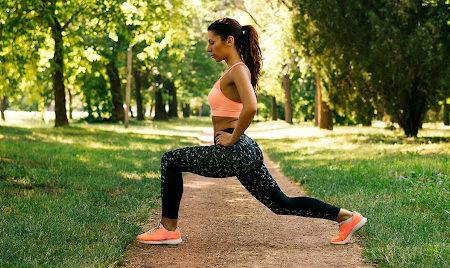Q: I’m interested in using the German Body Comp program to train for Brazilian jujitsu. Is that appropriate?
A: They say imitation is the sincerest form of flattery, but it’s not all that flattering when the imitators don’t do justice to the original work. Case in point: the German Body Comp program.
The German Body Comp program, one of my most popular workouts, is based on the pioneering research by a Romanian exercise scientist who defected to West Germany. Halarambie made the important discovery that the lactic acid pathway is better for fat loss than the commonly accepted aerobic pathway. He found that high blood lactic levels decrease blood pH levels, which in turn sends a message to the brain to accelerate its production of growth hormone. Higher growth hormone counts increase fat loss.
The GBC program is characterized by short rest intervals and multijoint movements to generate maximum growth hormone production. Not only does GBC result in greater fat loss than aerobic programs can produce, but it won’t sacrifice strength and muscle mass—in fact, it can make you bigger and stronger. With aerobics, all you get is fat loss and weakness. Why train your body to be weak?
How effective is the program? I’ve seen men gain 12 to 18 pounds of muscle in 12 weeks while losing fat, and it’s not uncommon for women to lose seven percent bodyfat in the same time period.
In addition to being great for anyone who wants to lose bodyfat, the GBC program is especially geared toward athletes because it develops muscular endurance. Law enforcement officers are prime candidates for the benefits of GBC, and I’ve had great success with grapplers and hockey players. In contrast, aerobic training does little to improve endurance for most sports and will compromise strength and power—it’s even been shown that upper-body aerobic training can compromise jumping ability. Which brings us back to the imitation problem.
The workout that is outlined in my book German Body Comp Program is designed for all levels of individuals. It’s a mix of machines and free weights, with the exercises increasing in difficulty—along with the overall volume of training—with the higher levels. Unfortunately, when fitness writers attempt to modify the program for athletes, they often make several critical errors in program design.
To show you how it’s supposed to be done, here’s a version for athletes who need to put on lean tissue and prepare for the months ahead of heavy lifting. Typically, the program is done by throwers and rugby players in the early off-season or by grapplers who want to take some time off the mat and build their lactate capacity; so in your case that would work. Obviously, these athletes will know their way around the weight room. It’s an advanced program and not for the weak of stomach.
Monday
A1 Snatch pulls on podium 5 x 6, X/O/X/O tempo
Rest 45 seconds
A2 Walking lunges 5 x 6 steps per leg, X/O/X/O tempo
Rest 45 seconds
Rest three minutes after completing all A sets
B1 Cyclists’ back squats 4 x 6-8, 3/0/X/0 tempo
Rest 45 seconds
B2 Close, parallel-grip chinups 4 x 6-8, 3/0/X/0 tempo
Rest 45 seconds
Rest 3 minutes after completing all B sets
C1 Lying leg curls (feet plantar flexed)
4 x 6-8, 3/0/X/0 tempo
Rest 45 seconds
C2 Incline dumbbell presses (semi-supinated grip)
4 x 6-8, 3/0/X/0 tempo
Rest 45 seconds
Rest 3 minutes after completing all C sets
Tuesday
A1 Clean deadlifts on podium 5 x 6,
4/O/X/O tempo
Rest 45 seconds
A2 Sternum chinups 5 x 6, 2/0/X/0 tempo
Rest 45 seconds
Rest 3 minutes after completing all A sets
B1 Russian stepups 4 x 8-10, X/0/X/0 tempo
Rest 45 seconds
B2 V-bar dips 4 x 8, 3/0/X/0 tempo
Rest 45 seconds
Rest 3 minutes after completing all B sets
C1 Lying leg curls (feet plantar flexed and
turned outward) 3 x 6-8, 3/0/X/0 tempo
Rest 45 seconds
C2 Seated dumbbell presses (semi-supinated grip)
3 x 6-8, 3/0/X/0 tempo
Rest 45 seconds
C3 Seated dumbbell external rotations
(elbow on knee) 3 x 6-8, 3/0/X/0 tempo
Rest 45 seconds
Rest 3 minutes after completing all C sets
Thursday
A1 Power cleans on podium 5 x 6, X/O/X/O tempo
Rest 45 seconds
A2 Lumberjacks 5 x 6, X/0/X/0 tempo
Rest 45 seconds
Rest 3 minutes after completing all A sets
B1 Front squats (narrow stance with heels elevated)
4 x 4-6, 3/2/X/0 tempo
Rest 45 seconds
B2 Incline thick-bar presses 4 x 6-8, 3/0/X/0 tempo
Rest 45 seconds
B3 Lean-away pullups 4 x 6-8, 30X0 tempo
Rest 45 seconds
Rest 3 minutes after completing all B sets
C1 Lying leg curls (feet plantar flexed and
turned inward) 3 x 6-8, 3/0/X/0 tempo
Rest 45 seconds
C2 One-arm bent-over shrugs 3 x 8-10, 2/0/1/2 tempo
Rest 45 seconds
C3 Low-pulley external rotations 3 x 10-12,
3/0/X/0 tempo
Rest 45 seconds
Rest 3 minutes after completing all C sets
Friday
A1 Snatch deadlifts, 10 x 6, descending-sets style, resting only 45 seconds; decrease the weight on every set so you can get the reps
Rest 5 minutes after competing all A sets
B1 Thick-bar curls, 8 x 8, descending-sets style, resting only 45 seconds; decrease the weight on every set so you can get the reps
B2 Decline EZ-curl-bar triceps extensions, 8 x 8, descending-sets style, resting only 45 seconds; decrease the weight on every set so you can get the reps
The best time for athletes to use this workout is as soon as the competitive season is over so your body can get accustomed to the change in body composition. After you try it and your teammates and competitors see your great results, don’t be surprised if they start imitating you!
Q: What do you think is the best trap exercise?
A: Besides the competitive Olympic lifting exercises and their assistance moves, one of my favorites for developing the traps is the one-arm barbell shrug. It’s great for stimulating strength and size gains in the traps and offers several advantages over conventional shrugs.
Compared to the two-arm barbell shrug, the one-arm version provides a greater range of motion. Try it if you don’t believe me. You’ll instantly feel how much higher the trapezius moves upward when you use the single-arm version. In fact, I would say that the only equivalent exercise would be shoulder shrugs using the Atlantis shrug machine, such as the one we have at the Poliquin Strength Institute.
There’s no contact with the body during one-arm barbell shrugs, permitting a much smoother performance. With dumbbells there’s a considerable amount of friction created as the plates rub against your body, especially with heavy weights. The friction increases the resistance of the movement, but you can’t actually determine how much the load has increased and, consequently, how well you’re progressing with the exercise.
With this version of the shrug, the working arm has to remain in a neutral position. The technique helps correct the excessively internally rotated shoulder and arm posture commonly associated with individuals who have bench-pressed excessively for years.
Finally, to prevent the barbell from moving toward the front of the body, the one-arm barbell shrug requires the infraspinatus and teres minor to be recruited isometrically. The additional work develops superior shoulder integrity that would be valuable for football and rugby players, who experience a high degree of disruptive forces to the shoulders during their sports. Although it seems like a simple movement, here are some special tips on how to get the most out of the one-arm barbell shrug.
First, to make it easier to load the barbell and pick it up, set the barbell on a power rack across the pins. You can then brace yourself with your free hand against one of the power rack posts, which will let you keep your torso upright. I would recommend the use of straps only if the weight is so heavy that your grip gives out—so no straps for sets of one to three reps.
To increase time under tension, which favors greater hypertrophy, pause for a predetermined time—one to six seconds, for example—at the end of the concentric range of motion. I prescribe that pause for people who are recovering from shoulder surgery, as they often cannot handle high loads but still need the hypertrophy to rehabilitate quickly.
If your traps are in need of a dire challenge, please give the one-arm barbell shrug a try. I’m certain you’ll be very happy with the quick results it provides, and adding it to your program would pay tribute to the pioneering work of the old-time bodybuilders and strength athletes.
Editor’s note: Charles Poliquin is recognized as one of the world’s most suc-cessful strength coaches, having coached Olympic med-alists in 12 different sports, including the U.S. women’s track-and-field team for the 2000 Olympics. He’s spent years researching European journals (he’s fluent in English, French and German) and speaking with other coaches and scientists in his quest to optimize training methods. For more on his books, seminars and methods, visit www.CharlesPoliquin.net. IM




















You must be logged in to post a comment Login